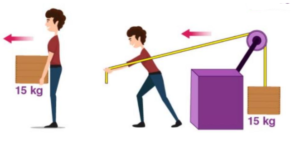
Solution:
(a) As the satellite approaches the Earth, its potential energy drops, and since the system’s total energy should remain constant, the kinetic energy increases. As a result, the satellite’s velocity rises. Despite this, atmospheric friction reduces the total energy of the system by a small amount.
(b)
Scenario I:
![]()
Displacement of the object will be ![]()
![]()
![]() is the angle between the force and displacement
is the angle between the force and displacement
![]()
![]()
![]()
![]()
Scenario II:

The direction of the applied force and displacement is same.
![]()
![]()
![]()
![]()
![]()
![]()
Thus, the work done is more in the second scenario.
